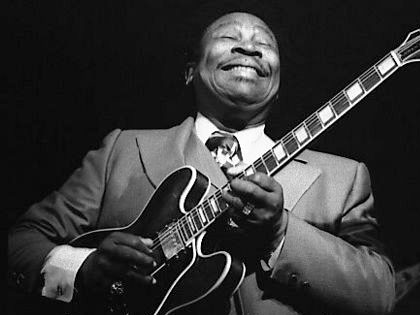 I sometimes wonder why I like a particular blues guitarist. I wish I could pin it down to just one thing… but it’s about many things. But I think I’ve narrowed it down to three factors I call the Three T’s. It’s the tone, the taste and the technique. That’s what matters to me.
I sometimes wonder why I like a particular blues guitarist. I wish I could pin it down to just one thing… but it’s about many things. But I think I’ve narrowed it down to three factors I call the Three T’s. It’s the tone, the taste and the technique. That’s what matters to me.
And over the years my understanding of these three things has changed too. Many of the guitarists I loved in my 30’s I just don’t like as much now. I suppose it has to do with the fact that I’ve learned so much more about the blues than I understood back then. I know more about tone, about taste and about technique.
Of course just because I’ve learned more it doesn’t mean I can do more. My tone, my taste and my technique have gotten better, but they’re still far from where I would like them to be. I guess that’s what keeps us playing and practicing. We keep working to get better and reach that place we want to be. And of course that bar goes up as we learn more so it’s really a never-ending process.
So what exactly do I mean by Tone, Taste, and Technique?
Guitar Tone
Another one of those things that changes over time. I use to love big fat distorted tones like early Eric Clapton or Jimmy Hendrix, or even AC DC’s Angus Young, but as I’ve gotten older I appreciate the cleaner sounds and full tonal range of a B.B. King or a T-Bone Walker or a Ronnie Earl. It’s not just all midrange any more. It’s about a full-range tone with highs and lows and sometimes clean and sometimes with an edge.
It’s definitely subjective but I know a great tone when I hear it. It just sounds full and sweet and full of emotion. And obviously that’s hard to explain or put into words.
And sometimes a tone with a little distortion still works for me. I would call my own tone at least overdriven these days but a lot of that comes from the amp I use and the Tube Screamer pedal I use as well.
And certainly the guitar amp has a lot to do with it. I’ve always liked older Fender amps like a Super, Twin or a Deluxe. Certainly I like tube amps over solid state amps. Most guitarists do. I’m actually using one of the new Super Champs now and I love it. But it’s far from a traditional, vintage Fender.
But all Fender amps don’t sound good to me. The DeVille series just sounds too mid-rangy and doesn’t have that big clean bottom end like a Twin does. But again that’s just me. I see lots of players using them that sound great. I just can’t make them sound good to me.
And Marshall amps too… I’ve never been a Marshall amp guy. Whenever I tried one it always sounded too thin to me. Not enough low end and a gnarly high end. But again that’s just me. I hear Joe Bonamassa using one and he sounds great.
And that’s kind of the point. I could play through his amp and just not sound like him. That’s because I’m not him. I’m me with my own style and type of guitar, so I have to find what works for me. And that means a constant search. I’ve had many guitar amps over the years (I wish I still had a few of them now). But I’m very happy with my sound these days.
Of course when I hear a blues guitarist that has a great tone, the first thing I want to know is what kind of amp do they use. That’s why we’ll have a whole section of our site dedicated to letting you know what amps blues players are using these days.
Taste
Now taste is one of those things that is really subjective. Just like tone, what passes for great, tasty playing has changed over the years for me. Less is more has definitely become my motto. I’ve learned it’s as much about what you don’t play as what you do play.
A tasty lead to me is one that starts out at a lower volume with very sparse playing and then slowly builds along with the band. It can then build to louder and more intense playing, but the band has to be with you every step of the way.
And the band is key here.
The lead needs to build as one with all the musicians building together. The rhythm guitar and the bass and drum parts are simple to start and build both in volume and complexity as the lead grows. The lead guitarist can’t do it by themselves. In fact, they can still play a very simple part but with high energy and as long as the band is cooking underneath it all seems to work. Anson Funderburgh and his band is one of the best at this. Sometimes his leads seem to get simpler as he progresses but the band is building behind him so it just seems like the lead is getting hotter and more intense. Here’s a video of Anson showing what I mean.
Great Examples
Shift Through Those Gears
I often think of a lead as a car moving through the gears. There’s a 1st gear part with a 1st gear rhythm part accompanying it. It then moves into 2nd gear and the band starts playing 2nd gear parts to make it work. That part is often louder and harmonically higher and perhaps with more notes going on. It’s dynamically more intense.
And the dynamics is a key element. More about what I mean by that later.
Then the lead moves through 3rd and 4th gear or through as many gears as the band can handle. Here’s Ronnie Earl showing you what I mean. Listen to what the band is playing behind him. And watch when he brings it down. Sorry about the quality.
And that’s one of the reasons I love the blues. It’s very improvisational when it comes to a lead. I never play the same lead twice. It has to be organic and responsive to what other people are playing around me. It’s kind of like surfing. You’re trying to “catch the wave” and ride it as long as you can. That wave comes from the band and a great rhythm section.
Technique
Now this is probably the least important of the 3 T’s. Sure you want to have some good technique and the larger blues vocabulary you have the better. But Technique without Taste and Tone is pointless to me. Just because you can play a lot of notes doesn’t mean that it makes the lead better. It doesn’t make it good music. The notes have to have meaning and feeling to them or it’s all just musical masturbation. There I said it.
But having said that, developing your technique is a critical part of getting better as a blues musician. Certain licks can really work to make a solo effective, especially as you move through the gears of a solo. So yes, improving your technique and learning new licks is an important part of growing as a blues guitarist.
The important part about technique for the blues is knowing what is correct for the style of song you are playing. When you move to swing and jump blues, you need to be playing scales and licks that are appropriate for that style. You can’t be playing major pentatonic rock licks when you are playing over 9th and 6th chords. You can.. but it just won’t sound as good.
So we’ll be providing lots of instruction on how to increase your blues vocabulary by learning new blues licks and what scales and licks are right for the style of music.
But what do you think? I’d love to hear your thoughts on what makes a great blues guitarist.




You have hit the nail right on the head with what you say. I can only add to that and can say if you aint got emotion and soul your playing wont produce the same meaning. I have a gig tonight and i been depressed this week so i’ll have plenty of emotion coming through tonight. My rig is a 63 strat and a 60s blackface vibrolux reverb. 12 months ago i was using a blackface 60s pro reverb but i was finding my sound a bit thin cause it was a big sound in a small room. Since i dropped in wattage with the vibrolux its always on high volume giving me a nice bluesy smokey tone and i use the volume control on guitar like old school players dropping to 7 on the volume pot and increasing to full with solo which adds gain overdrive and sustain. I now use the pro for bigger rooms and festivals and im getting the same affect. These amps make 90% guitars sound good. The only pedal i use now is a 80s dunlop wah which had a cry baby pot added in the 90s for that funk blues.
Hi Rick –
The BLUES is such a diverse genre and has many styles and I think you are right with the 3 “T”s – and I think that the key to some of it is to be a bit adventurous with your playing – don’t be afraid to try different things – we all should develop our own style – unless you just want to be a cover blues player – but playing what everyone else plays is ok to a point but doesn’t show any individuality, which is something that I think is essential to the Blues ….
I think that some of the players mentioned took some of the basic licks and tricks of the early players as most of us do and then developed their own styles from there – whatever you try if it sounds good to your ears then it seems to stick in the mind and develops from there …
A players personality has a lot to do with it – probably more than many realise – we are all individuals and have similar but different likes and dislikes and tastes in who and what we like to listen to and play …
Being creative is the best part of bending strings – I love the freedom of the fretboard … I have just recently finished my Fender Bassman amp clone and with a digital reberb and a couple of pedals in the chain I have nailed the tone I have been looking for and really having a great time with it and my playing has improved – which is part of the secret to it all … If you want to get enthusiastic with the blues then you have to find that tone you are chasing and after you have found it then everything seems a little easier – getting what you want to express through the amp is an essential ingredient to blues playing – cut loose and let rip – have a good time with the fretboard and be creative …. it makes you feel good … ooh yeah !
If you aren’t getting much out of your playing then keep on trying different amps till you find that one that will inspire you and you will be feeling better with what you are playing … the rest will follow …
I have just bought myself a cheapie Dobro to have a crack at some slide style and tuned to open G I just love it – it has and will open another door for me ….
Cheers and all the best from Australia.
Greg – aka frostbite
COOMA NSW